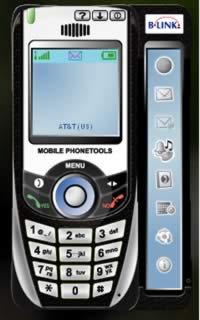 If you’ve ever spent hours shouting at the little blinking blue light on your laptop screaming, “what do you mean you can’t find my phone? IT’S THERE!!”, then you may find Broadcom’s new BLINK Bluetooth software (Bluetooth-Link = BLINK, getit?) bringing your blood pressure down.
If you’ve ever spent hours shouting at the little blinking blue light on your laptop screaming, “what do you mean you can’t find my phone? IT’S THERE!!”, then you may find Broadcom’s new BLINK Bluetooth software (Bluetooth-Link = BLINK, getit?) bringing your blood pressure down.
Claiming to “radically simplify Bluetooth connectivity between cell phones and PCs”, the software is the result of a collaboration between Broadcom and BVRP Software International (now Avanquest Software), and has already adopted by networking retailers such as Anycom and IO GEAR, as well as a ton of Bluetooth dongle manufacturers.
Although Bluetooth-enabled phones continue to grow in popularity, many people are put off using the functionality because of problems getting some devices to talk to each other.
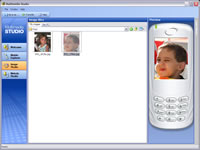 BLINK software claims to soothe the troubled brows of baffled Bluetooth uses with an intuitive graphical user interface (GUI) that makes complex Bluetooth-related tasks “as simple as browsing the Internet.”
BLINK software claims to soothe the troubled brows of baffled Bluetooth uses with an intuitive graphical user interface (GUI) that makes complex Bluetooth-related tasks “as simple as browsing the Internet.”
“This software simplifies the use of Bluetooth technology to such an extent that we anticipate ‘BLINK’ to become synonymous with Bluetooth when connecting phones and PCs using products based on our technology,” said Scott Bibaud, Senior Director of Marketing for Broadcom’s Bluetooth products.
Beaming with confidence, Scott continued, “Once users discover the convenience of ‘BLINKing’ files and data between their phones and PCs, the true power of Bluetooth will become clearer to the millions of consumers that already have the technology built into their phones.”
 Once fired up, the BLINK software serves up a graphical representation of the user’s mobile phone on their desktop or notebook PC screens.
Once fired up, the BLINK software serves up a graphical representation of the user’s mobile phone on their desktop or notebook PC screens.
Once connected, users can operate all the main phone functions directly from the computer, and drag and drop items from their PCs directly to their cell phones.
Via the BLINK interface, users can update and synchronise phone numbers, contact information and calendars as well as transfer pictures, music and data.
The Internet can also be accessed on the desktop via any GPRS/EDGE/CDMA cellular data links and SMS messages can be sent and received.
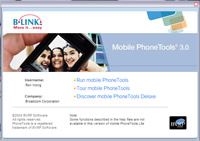 “Digital photos, phone numbers and calendar appointments are literally trapped inside users’ cell phones because of the complexity involved in transferring this information to PCs and other devices,” said Brian O’Rourke, Senior Analyst at In-Stat.
“Digital photos, phone numbers and calendar appointments are literally trapped inside users’ cell phones because of the complexity involved in transferring this information to PCs and other devices,” said Brian O’Rourke, Senior Analyst at In-Stat.
“Broadcom’s leading work in Bluetooth software will not only lead to greater penetration of Bluetooth hardware in a number of applications, it will also make it easier to use for these advanced tasks,” he added.
Broadcom will be shoving a copy of the software into our grubby hands shortly so check back soon.
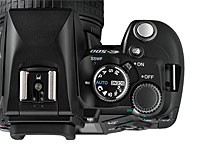 Competition at the lower end of the dSLR market looks set to heat up as Olympus launch their new Four Thirds System digital SLR, the E-500 (called the ‘Olympus EVOLT E-500’ in North America).
Competition at the lower end of the dSLR market looks set to heat up as Olympus launch their new Four Thirds System digital SLR, the E-500 (called the ‘Olympus EVOLT E-500’ in North America).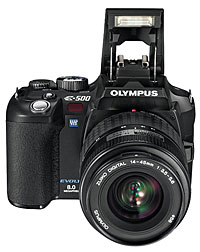 Dominating the back of the camera is a large, 2.5″ HyperCrystal 215k LCD monitor offering a wide viewing angle.
Dominating the back of the camera is a large, 2.5″ HyperCrystal 215k LCD monitor offering a wide viewing angle.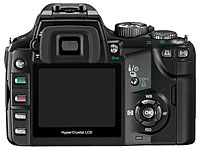 Storage is taken care of by CompactFlash Type II and xD Picture card memory card slots, with the camera capable of taking up to 4 RAW/TIFF/SHQ images in a row at 2.5 frames/second; with shooting continuing until the memory card is full at HQ quality.
Storage is taken care of by CompactFlash Type II and xD Picture card memory card slots, with the camera capable of taking up to 4 RAW/TIFF/SHQ images in a row at 2.5 frames/second; with shooting continuing until the memory card is full at HQ quality.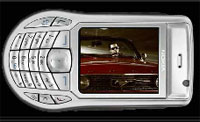 Virgin’s ‘independent-style’ record label, V2 Music has teamed up with mobile video solutions developer Rok Player to announce the release of an ‘indie music video album’ for playing on mobile phones.
Virgin’s ‘independent-style’ record label, V2 Music has teamed up with mobile video solutions developer Rok Player to announce the release of an ‘indie music video album’ for playing on mobile phones. Using Rok Player technology, indie kids can play back audio-visual content preloaded on memory cards at an impressive 24 frames a second (full screen) on compatible mobile handsets.
Using Rok Player technology, indie kids can play back audio-visual content preloaded on memory cards at an impressive 24 frames a second (full screen) on compatible mobile handsets. “This is such an exciting development in the distribution of music videos” enthused Beth Appleton of V2 Music “as nearly everyone has, or will have, a compatible mobile phone and ROK Player turns those into portable DVD players. So now, for the first time, people can watch as well as listen to their favourite artists perform”.
“This is such an exciting development in the distribution of music videos” enthused Beth Appleton of V2 Music “as nearly everyone has, or will have, a compatible mobile phone and ROK Player turns those into portable DVD players. So now, for the first time, people can watch as well as listen to their favourite artists perform”. Bruce Renny of ROK , commented, “We’re already seeing tremendous interest in our music video albums for mobile phones, and to be able to include this new title in our portfolio is tremendous. We’re expecting the V2 album to prove very popular indeed because of the high quality of the artists it features”.
Bruce Renny of ROK , commented, “We’re already seeing tremendous interest in our music video albums for mobile phones, and to be able to include this new title in our portfolio is tremendous. We’re expecting the V2 album to prove very popular indeed because of the high quality of the artists it features”.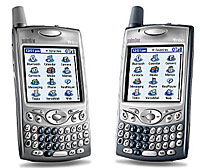 To the sound of a thousand wailing Palm Pilots, Palm has unveiled a version of the classic Treo smartphone running on Windows Mobile 5.0.
To the sound of a thousand wailing Palm Pilots, Palm has unveiled a version of the classic Treo smartphone running on Windows Mobile 5.0.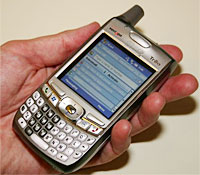 Palm users still waiting for the Wi-Fi card categorically promised at the
Palm users still waiting for the Wi-Fi card categorically promised at the 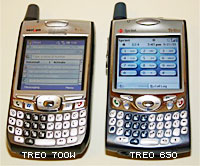 Carmi Levy, Senior Research Analyst at Info-Tech Research Group commented that the new Treo signals a massive shift in the handheld/smartphone market, adding that “when viewed in conjunction with the sale of PalmSource earlier this month, it’s an acceleration in the demise of the Palm OS platform and final confirmation that its once-dominant position in the broader handheld market is gone for good.
Carmi Levy, Senior Research Analyst at Info-Tech Research Group commented that the new Treo signals a massive shift in the handheld/smartphone market, adding that “when viewed in conjunction with the sale of PalmSource earlier this month, it’s an acceleration in the demise of the Palm OS platform and final confirmation that its once-dominant position in the broader handheld market is gone for good. There’s been no release date set for the Windows-based Treo yet, but it is expected to be available “very early” in 2006.
There’s been no release date set for the Windows-based Treo yet, but it is expected to be available “very early” in 2006.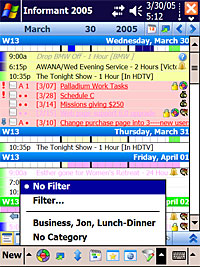 Pocket Informant 2005 is an integrated Pocket PC application that replaces the built-in Calendar, Contacts, Tasks, Notes, Journal programs and adds a Timeline view.
Pocket Informant 2005 is an integrated Pocket PC application that replaces the built-in Calendar, Contacts, Tasks, Notes, Journal programs and adds a Timeline view.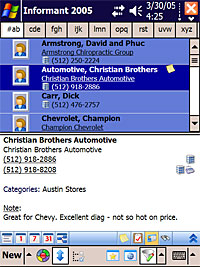 Contacts
Contacts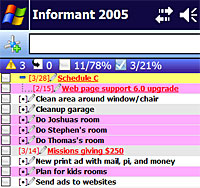 Tasks
Tasks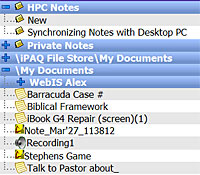 Notes
Notes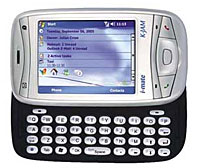 Building on the success of their hugely popular JAM phone, i-mate have announced the new K-JAM smartphone/PDA.
Building on the success of their hugely popular JAM phone, i-mate have announced the new K-JAM smartphone/PDA.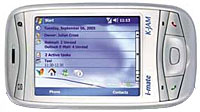 The display comes in the form of a 2.8″ QVGA (240 x 320 pixels) 64k Transflective screen, and the device runs on the latest Windows Mobile 5.0 OS.
The display comes in the form of a 2.8″ QVGA (240 x 320 pixels) 64k Transflective screen, and the device runs on the latest Windows Mobile 5.0 OS. The phone offers support for a wide range of music formats, and claims 10 hours running time in PDA mode and 4-5 hours talk time.
The phone offers support for a wide range of music formats, and claims 10 hours running time in PDA mode and 4-5 hours talk time. Finnish mobile giants Nokia have come up with the Nokia 3250, a new music-driven mobile phone featuring dedicated music keys and storage for up to 750 songs.
Finnish mobile giants Nokia have come up with the Nokia 3250, a new music-driven mobile phone featuring dedicated music keys and storage for up to 750 songs.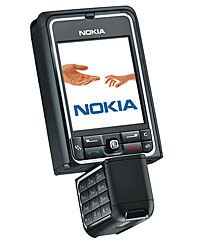 Songs can be converted from CD and transferred from home PCs using the “drag and drop” Nokia Audio Manager software.
Songs can be converted from CD and transferred from home PCs using the “drag and drop” Nokia Audio Manager software.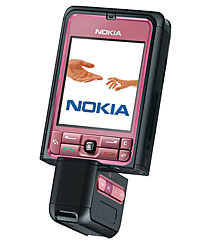 “Nokia connects people to their passions – music – and as the world’s largest manufacturer of digital music players, Nokia is leading the charge to make mobile music widely accessible. The XpressMusic feature brand, also introduced today, makes it easier for consumers to identify those Nokia devices which are specifically designed to listen to music,” purred Kai Öistämö, Senior Vice President, Mobile Phones, Nokia.
“Nokia connects people to their passions – music – and as the world’s largest manufacturer of digital music players, Nokia is leading the charge to make mobile music widely accessible. The XpressMusic feature brand, also introduced today, makes it easier for consumers to identify those Nokia devices which are specifically designed to listen to music,” purred Kai Öistämö, Senior Vice President, Mobile Phones, Nokia. An Australian production company has made what they are claiming is the first music video shot entirely with mobile-phone cameras.
An Australian production company has made what they are claiming is the first music video shot entirely with mobile-phone cameras.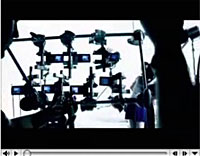 A multiplicity of mobiles (which look like Sony Ericsson k750i’s to us) were set up on frames and tripods with handheld footage recorded by four crew members who wandered around the band as they played, with the footage being sent via Bluetooth to laptops.
A multiplicity of mobiles (which look like Sony Ericsson k750i’s to us) were set up on frames and tripods with handheld footage recorded by four crew members who wandered around the band as they played, with the footage being sent via Bluetooth to laptops. The director of music video, Grant Marshall from Film Headquarters tries to explain, ‘We came up with this idea 18 months ago but couldn’t find a band that would embrace the risk and vision. P.U.S.A loved the concept and were brave enough to undertake the risk. This was a fantastic experience for all of us. The band was fabulous and incredibly professional.”
The director of music video, Grant Marshall from Film Headquarters tries to explain, ‘We came up with this idea 18 months ago but couldn’t find a band that would embrace the risk and vision. P.U.S.A loved the concept and were brave enough to undertake the risk. This was a fantastic experience for all of us. The band was fabulous and incredibly professional.” Following on from his review of the
Following on from his review of the  With support for more than ten monitors, UltraMon adds a raft of user-configurable tools to help users get a manly grip on their acres of screen real estate.
With support for more than ten monitors, UltraMon adds a raft of user-configurable tools to help users get a manly grip on their acres of screen real estate.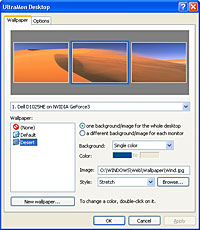 These little fellas let you quickly shunt programs across to other screens with a single click, or maximise a single window across the entire desktop.
These little fellas let you quickly shunt programs across to other screens with a single click, or maximise a single window across the entire desktop.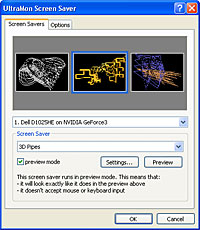 The program also lets you stretch desktop wallpapers and screen savers across multiple screens or set a different picture and screen saver for each screen, which can look way cool!
The program also lets you stretch desktop wallpapers and screen savers across multiple screens or set a different picture and screen saver for each screen, which can look way cool!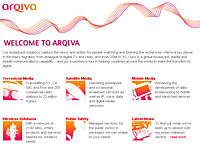 UK operator O2 has announced a mobile TV pilot letting 400 customers in Oxford to choose from 16 channels, featuring popular shows such as Lost, EastEnders, Coronation Street
UK operator O2 has announced a mobile TV pilot letting 400 customers in Oxford to choose from 16 channels, featuring popular shows such as Lost, EastEnders, Coronation Street O2’s chief technology officer, Dave Williams, feels that the trial will help in establishing a model for more projects in the future, commenting. “By establishing relationships through activities such as this, we hope that potential challenges will be minimised and mobile TV becomes a commercial reality sooner than is currently possible.”
O2’s chief technology officer, Dave Williams, feels that the trial will help in establishing a model for more projects in the future, commenting. “By establishing relationships through activities such as this, we hope that potential challenges will be minimised and mobile TV becomes a commercial reality sooner than is currently possible.”